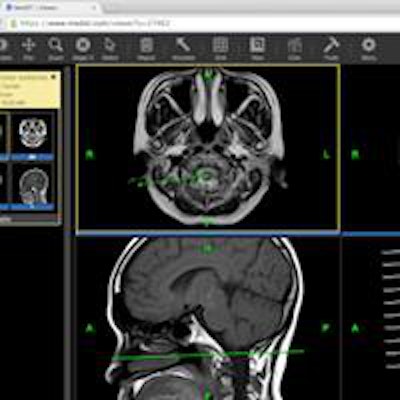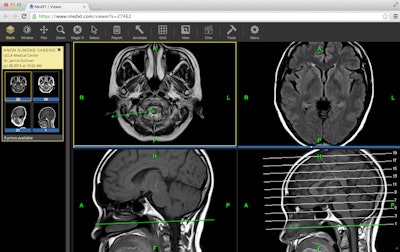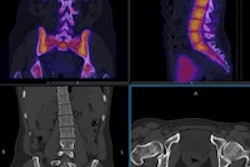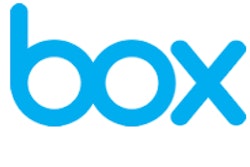
A number of imaging pundits over the years have wistfully wondered why advances in consumer-oriented information technologies aren't applied more broadly to imaging informatics. San Francisco start-up MedXT hopes to bridge that technology gap with its cloud-based RIS/PACS software.
Available via a pay-per-use, software-as-a-service (SaaS) model, the firm's complete RIS/PACS features an HTML5 Web-based universal image viewer and cloud storage handled primarily by Amazon Web Services.
"Imaging is such an interesting subset of healthcare software," co-founder and CEO Cody Ebberson told AuntMinnie.com. "It was one of the first to embrace digital, but then at some point it stagnated a little bit."
MedXT executives believe that technology from the consumer IT industry can help liven up imaging informatics. Ebberson began his career at Microsoft and has spent time in a number of consumer technology companies, while MedXT's chief technology officer, Reshma Khilnan, got his start at Microsoft and has worked at Facebook.
"We worked on consumer applications that were designed to scale to tens of millions of people," he said.
Ebberson later signed on as chief operating offer at teleradiology services provider 24/7 Radiology. Coming into the radiology IT world was a little bit of a culture shock, he said.
"Usability of software isn't quite as good, and things like uptime and reliability are not quite what they are in some of the consumer tech products that we're familiar with," he said. "So for me that was a big eye-opener to the opportunities that exist in this space."
A cloud-based platform
After 24/7 Radiology was sold in 2011 to Alliance Healthcare, Ebberson and Khilnan began working full-time in 2012 toward the goal of bringing best practices from the consumer technology world to the medical imaging market. MedXT relies on a key driver in consumer IT: cloud computing.
"We're big users of Amazon Web Services," he said. "We're one of the first companies to sign a business associate agreement with Amazon, and we've been able to leverage a lot of their resources. They've been extremely helpful with regard to compliance and security and working with the [U.S. Food and Drug Administration (FDA)] and other regulatory bodies to make sure that we're going to bring the best practices in scalability and security into this space."
In addition to cloud computing, consumer-oriented IT is also used for the firm's client software, an HTML5 DICOM viewer. While a few other companies have experimented with HTML5 viewing applications, MedXT "has taken it all the way to where we're using technologies such as WebGL, Web workers, [etc.,] to create what feels like a native experience, but you get all of the same ease-of-use benefits of it being in your Web browser; there's no software to install," Ebberson said.
The viewer supports diagnostic image viewing and has received FDA clearance.
"Sometimes there's a natural skepticism about Web browser-based technologies, but ... you can have your full four-monitor setup with all windows working in harmony with each other for the full diagnostic workstation," he said.
Viewer features
Standard image analysis tools are included in the viewer, as well as annotation and measurement options. Orthogonal multiplanar reconstruction is built into the software, and 3D surface-shaded rendering is expected to be incorporated later this year, Ebberson said.
 Screenshot of MedXT's universal image viewer. Image courtesy of MedXT.
Screenshot of MedXT's universal image viewer. Image courtesy of MedXT.Reporting functionality includes reporting templates, macros, and speech recognition, as well as report delivery tools such as built-in automatic faxing and HL7 interfaces to electronic health record (EHR) software. It also features billing integration via HL7 interfaces to a number of billing providers, Ebberson said.
In addition, the software supports patient access to images.
"This is where a lot of the cloud technologies start to open up a lot of interesting opportunities," he said. "Because you don't have to install any software, everything just works right there in your Web browser. Patients and referring physicians really get an excellent experience, almost the exact same diagnostic experience as the radiologist gets, right there in the Web browser."
The company believes that the benefits of the high-powered viewer with the anytime, anywhere access and ease of setup of the cloud model "completely dwarf any other perceived disadvantages of a cloud-based PACS," he said.
Sites that use teleradiology and pretty much anyone that has a distributed workflow could really benefit from the cloud model, according to Ebberson.
"We work with a lot of mobile practices, where they are sending portable ultrasound or portable x-ray devices out into the field and they need to send those images back to a central office," he said. "Teleradiology is distributed by nature, and we also have a lot of smaller clinics and family practices that might have multiple locations that are coordinated together, so it's also popular with them."
Storage platforms
While MedXT uses Amazon as its primary storage repository, it can also work with other storage platforms as well, Ebberson said.
"For example, we have a couple of customers in Europe where the regulatory environment is a little more strict and you have to actually have data stored within that country's borders," he said. "So we found local cloud partners to store data for those customers."
Prospective customers can sign up online for a trial and can upload their first 50 images for free. Approximately 80% of the company's installed base is in the U.S., and the firm is servicing approximately 400 to 500 facilities, ranging from a small individual group with a mobile ultrasound device to a full hospital, Ebberson said.
In addition to direct sales, MedXT is also interested in OEM partnerships with other firms. For example, the company has enabled its image viewer to work with Microsoft's HealthVault application.
In the short term, MedXT is working to incorporate more advanced image analysis tools into the software.
"Longer term, we're really excited about more of the interoperability, connectivity partnerships with other EHRs," he said.
The company also wants to work with researchers, such as in the area of computer-aided diagnosis.
"In my opinion, we're just at the very beginning of these assisted-diagnosis technologies," Ebberson said.




















